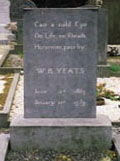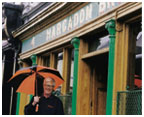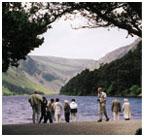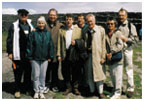|
September 13, 2000 Feature: Literary Landscapes
Yeats
to Beckett, Galway to Dublin by Paul Muldoon June 5. The first Alumni College in Ireland has a promising start: our plane leaves on time. As we take off from JFK for our overnight flight to Shannon, I reflect that it's been more than two years since I first got together with Michael Cadden, director of the program in theater and dance, to devise an itinerary that would offer a group of 30 alumni a wide-ranging and deep-seated sense of the literary landscape of Ireland. We've been greatly helped over those two years by Kathy Doyle '93, an assistant director at the Alumni Council, who has the distinct advantage of having pursued graduate studies in Irish literature at University College Cork, and is assisting us on the trip itself. She and our tour director, Patsy Leo from Academic Arrangements Abroad, are charged with making sure all goes smoothly from day to day - what W. B. Yeats might have described as "theatre business, management of men."
June 7. We checked in last night to the Glenlo Abbey hotel, just outside Galway, and were treated to a post-dinner concert by Dordan, an all-woman Irish band. The academic program got under way when I lectured this morning on the course of Irish poetry up to Yeats, not a subject that lends itself to being summarized in 50 minutes. We then set off for the Burren, the "moonscape" of exposed limestone in County Clare famous for its archaeological and botanical rarities. We were guided by Gordon D'Arcy, a Belfastman who's lived here for many years. This evening we're attending a performance at Galway's Town Hall Theatre of We Ourselves, a complex play by Paul Mercier that attempts to reflect some of the complexities of the new Ireland. The play consists of a series of monologues, spoken by friends who lived together only briefly while working in Germany and who are "reunited" by the death of one of their number.
June 9. I'm particularly excited today as we start out for the ferry to Inishmore, the largest of the Aran Islands, since this will be my first visit to that major site of literary pilgrimage. We climb to the astounding clifftop fortress of Dun Aengus, have lunch, potter about the craft shops. There's a huge array of Aran sweaters, each with a design particular to an island family so that, in the event of a drowning, a corpse might be identified by its sweater. June 10. This last detail would surely have appealed to Samuel Beckett, a man who delighted in the notion that "we give birth astride the grave." Beckett is the subject of this morning's lecture by Michael, after which we "go on" to Sligo, where we'll spend the next couple of nights. A few of our number make another pilgrimage, to Hargadon's pub, the family seat of Fred Hargadon, Princeton's dean of admission. This prompts me to start work on the following loose limerick:
June 11. Despite the fact that I've just delivered myself of that monstrosity, I seem to have no qualms about holding forth this morning on contemporary Irish poetry. After my lecture, we're joined in the Sligo Park hotel by two wonderful local writers. The first is Patrick McCabe, best known for his novel The Butcher Boy, which was made into a movie by Neil Jordan. The second, who also happened to have an acting role in The Butcher Boy, is Dermot Healy, the author of several novels and a brilliant memoir, The Bend for Home. We then take a tour of some of Yeats country, visiting Drumcliff, where the poet is buried, and coming close to getting a glimpse of the elusive "Lake Isle of Innisfree." This evening we attend "a special Yeats Candlelit Dinner," an entertainment put on at a local restaurant. Not the literary high point of our trip, perhaps, but mildly amusing. June 12. An early departure for Dublin and the Westbury Hotel, our home from home for the rest of the Alumni College. We're joined for a couple of days by President Harold Shapiro and his wife, Vivian Shapiro, who are vacationing in Ireland and who accompany some of us to the Abbey Theatre for a performance of a version of Euripides' Medea, with the great Fiona Shaw in the title role.
June 14. Coincidentally, Marina Carr was for a time Writer in Residence at Holles Street Maternity Hospital, the setting of Chapter 14 of James Joyce's Ulysses. That is the chapter in which Mrs. Purefoy gives birth, it seems, to the great tradition of prose in English, since in describing her labor Joyce parodies successive authors from anonymous Anglo-Saxon chroniclers to 20th-century babblers. In his lecture this morning, our guest, Jack McCarthy '69, maps with great aplomb the Dublin locations, including Holles Street, visited by Stephen Dedalus or Leopold Bloom on June 16, 1904 - "Bloomsday," as it's now known. June 15. One of the locations we visit today is the Martello tower in Sandycove in which the opening chapter of Ulysses is set, the tower that Stephen Dedalus thinks of as the "omphalos," or navel, of a new "Hellenic" Ireland. In my introduction this evening to Seamus Heaney, the great Irish poet who won the Nobel Prize for Literature in 1995 and who has graciously agreed to read to us, I remark that one of his many achievements has been to relocate the "omphalos" in the well-pump on a small holding in County Derry, where he spent his childhood. We're joined on this occasion by a group of our friends and colleagues from Harvard University, where Heaney teaches.
My offering: Was it Liam or was it
Noreen Born in Northern Ireland, Paul Muldoon lived until 1986 in Belfast, where he was a producer for the BBC. At Princeton, he is the Howard G.B. Clark '21 University Professor in the Humanities, director of the creative writing program, chair of the Fund for Irish Studies, and unofficial poet-in-residence. Suggested further reading: James Joyce, The Portable James Joyce, Harry Levin, Editor. (Viking Press, 1976). William Butler Yeats, The Collected Poems of W .B. Yeats, Richard J. Finneran, Editor. (Scribner, 1996). R. F. Foster, Modern Ireland, 1600-1972. (Penguin, 1993). John Millington Synge, The Aran Islands. (Penguin Twentieth Century Classics, 1992). John Millington Synge, The Playboy of the Western World and Other Plays. (Signet, 1997). Samuel Beckett, Waiting for Godot. (Grove Press, 1997). On the Web: Irish events: www.princeton.edu/~visarts/Irish_Studies.htm Alumni College information: www.princeton.edu/~alco/coll_events.html The
inferno at the castello By Marianne Eismann
Until that moment in 1998, Kate St. John had believed that the Dante Reunion in Tuscany would be fun. No longer so sure, she turned to her husband and said, "It sounds like a cult."
Susan Saltrick '78, one of the Tuscan trip's principal organizers, says she made the trip "to get that contact high one gets from being in a seminar with Bob and all those bright lights around him." Christy McBride '97 agrees. "Everyone here is drawn to this event not just by Dante, but by Hollander." Indeed, Dante and Hollander are at the heart of this latest Dante expedition, what Carolyn Calvert Phipps '76 describes as a "grass-roots Alumni College." Under Hollander's inspiration and leadership, several Dante course alumni, led by John "President" Adams '72, designed a rigorous seminar on the Inferno to be conducted at the beautiful Castello di Santa Maria Novella, a working vineyard set halfway between Florence and Siena that produces Chianti and vin santo, a sweet, velvety dessert wine. During the week-long course, Hollander's morning seminars were followed by two-hour afternoon precepts led by his former students.
Although he's been studying and teaching Dante for 40 years and with his wife, poet Jean Hollander, is the author of a new translation of the poem, Hollander's approach to the Divine Comedy remains fresh and full of wonder. "Reading Dante is like listening to Bach," he says. "You just can't understand how a human being could produce that." Teaching the poem adds to the adventure. "The process of working with students on the poem changes the teacher. The poem gets into the students and works on them, and they work on you." Hollander appreciates the wonder of the Dante Reunion as much as his students do. When asked if he thinks about the rare thing it is for a teacher to have so many dedicated students come together to work with him years later, Hollander replies that he does, and that "the experience is so powerful that it is well beyond flattery, and simply real and a part of all our lives now." He is especially grateful, he says, for the "continued feeling of fellowship with students who are willing to learn and share their thoughts and feelings as they learn." In Tuscany, the group got to know each other quickly. This "vertical tasting," as Bill Charrier '69 described it, of Princeton graduates from 1955 to 1997 could not stop talking-at meals, on walks, in the pool, during three-hour dinners, before and after magical evening choral and chamber music concerts, over grappa and wine, and alongside the castle's parapet, where they could gaze down on the green-and-brown striated farmland of the Val d'Elsa. No one could bear to go to bed because there was so much to discover. Many held out only until 2 or 3 a.m. The younger or more determined hung on to climb the tower and greet the dawn. Though all of the 34 participants traveled to Tuscany to read Dante with Hollander, each had additional reasons for making the trip. For Italy reunion organizer Stephen Chanock '78, it was the opportunity to "step out of a hectic professional and family life" and find out why "a smart man like Bob Hollander devotes his life to studying the Divine Comedy." For Oliver Whitehead '70, the trip "was the apotheosis of what reunions should be-not just recalling your best academic experiences in a haze of beer, but really doing it again and better than before. As undergraduates we're amazingly privileged to have the chance to sit in groups day after day and share our ideas about great pieces of writing, but most of us don't really take advantage of the situation. So it's a great opportunity to have a second chance to join in the dialogue." Anne Charrier arrived with "trepidation because I had never studied Dante before" though she had read it when her husband, Bill, was taking Hollander's course. "I thought I'd sit in the back and be quiet. I never expected to get so excited and brazen enough to just charge in. This experience has been beyond my wildest dreams of what it would be." In seminar, Hollander directed his students' attention to Dante's iconoclastic combinations of high and low styles. The poet's encyclopedic range allows him to "represent great feeling" and yet "convince us that he knows what a cow's tongue feels like," Hollander said. The students' interactions, too, combined the high and the low. When Whitehead paused to work out a thought and added that he might "have to think aloud" to do it, Who Wants to Be a Millionaire invaded Tuscany. "Want to use your lifeline?" Hollander asked. On the last day, Linda Hastings reflected on the week in Tuscany, which the group hopes to repeat in 2002 with Purgatorio as its focus. "There's been so much laughter," Hastings said. Susan Saltrick expanded on the thought: The shared classes and concerts and readings point to "the power of art to bring us together in this little place in paradise," she said. "We'll pass away, but the walls and music and poem will live on." Marianne Eismann '79 first took Hollander's class in 1978 and has been a Dante Reunion regular since 1989. On the web: Bob Hollander's Dante Project: www.princeton.edu/dante |

 While
many people were hitting the beach this summer, two groups of Princeton
alumni were hitting the books. In June, professors Paul Muldoon
and Michael Cadden led some 30 people through Ireland, where they
studied together the works of Yeats, Synge, Joyce, and others and
hoisted a pint or two. Meanwhile, 34 devotees of professor Bob Hollander
'55's legendary Dante Reunion traveled to an 11th-century castle
and winery in Italy to delve more deeply into the Inferno. In the
following stories, Muldoon and Dante student Marianne Eismann '79
reveal just how these alumni spent their summer vacations.
While
many people were hitting the beach this summer, two groups of Princeton
alumni were hitting the books. In June, professors Paul Muldoon
and Michael Cadden led some 30 people through Ireland, where they
studied together the works of Yeats, Synge, Joyce, and others and
hoisted a pint or two. Meanwhile, 34 devotees of professor Bob Hollander
'55's legendary Dante Reunion traveled to an 11th-century castle
and winery in Italy to delve more deeply into the Inferno. In the
following stories, Muldoon and Dante student Marianne Eismann '79
reveal just how these alumni spent their summer vacations. June
6. The life and work of W. B. Yeats will be our area of concentration
for this first day or two. We've been augmented by our National
Guide, Noreen O'Farrell, and our coach driver, Liam Murray, to whom
we'll entrust ourselves for the duration of our journey. After a
heart-stopping "full Irish breakfast" complete with rashers,
black pudding, and grilled tomato, we set off for Thoor Ballylee,
the Norman tower which Yeats bought in 1915 for 25 pounds. It occurs
to me that it's just the sort of spot I should be living in myself,
so I vow to keep a weather eye open for another such fixer-upper
as we travel around the country. Given the booming economy in Ireland
- the so-called "Celtic Tiger" - the chances of picking
up anything for 25 pounds are now somewhat remote. After Thoor Ballylee,
we visit the ruins of Coole Park, the home of Lady Augusta Gregory,
complete with the famous copper beech on which so many of the writers
associated with Irish literature carved their initials, like students
at their desks in McCosh 50.
June
6. The life and work of W. B. Yeats will be our area of concentration
for this first day or two. We've been augmented by our National
Guide, Noreen O'Farrell, and our coach driver, Liam Murray, to whom
we'll entrust ourselves for the duration of our journey. After a
heart-stopping "full Irish breakfast" complete with rashers,
black pudding, and grilled tomato, we set off for Thoor Ballylee,
the Norman tower which Yeats bought in 1915 for 25 pounds. It occurs
to me that it's just the sort of spot I should be living in myself,
so I vow to keep a weather eye open for another such fixer-upper
as we travel around the country. Given the booming economy in Ireland
- the so-called "Celtic Tiger" - the chances of picking
up anything for 25 pounds are now somewhat remote. After Thoor Ballylee,
we visit the ruins of Coole Park, the home of Lady Augusta Gregory,
complete with the famous copper beech on which so many of the writers
associated with Irish literature carved their initials, like students
at their desks in McCosh 50. June
8. The day begins with a lecture by Michael on the work of John
Millington Synge, the playwright who, in Paris in 1896, was urged
by Yeats to go to the Aran Islands and "express a life that
has never found expression." After a tour of Connemara, and
a stop in the picturesque village of Clifden, we return to Galway
for a seminar on Yeats's poems. The animated discussion spills over
into dinner at Paddy Burke's oyster restaurant in Clarinbridge.
June
8. The day begins with a lecture by Michael on the work of John
Millington Synge, the playwright who, in Paris in 1896, was urged
by Yeats to go to the Aran Islands and "express a life that
has never found expression." After a tour of Connemara, and
a stop in the picturesque village of Clifden, we return to Galway
for a seminar on Yeats's poems. The animated discussion spills over
into dinner at Paddy Burke's oyster restaurant in Clarinbridge. A
man drinking bottles of stout
A
man drinking bottles of stout June
13. After a whistlestop lecture by Michael on contemporary Irish
drama, we take a whistlestop tour of County Wicklow. We pause longest
at the monastic site of Glendalough before returning to Dublin for
a reception with alumni residents of Ireland and a performance at
the Gate Theatre of On Raftery's Hill, a new play by Marina Carr.
We'd hoped that Ms. Carr, whose The Mai has been seen at the McCarter
Theatre, might join us this evening, but it turns out that she's
had a child this very morning and is otherwise engaged.
June
13. After a whistlestop lecture by Michael on contemporary Irish
drama, we take a whistlestop tour of County Wicklow. We pause longest
at the monastic site of Glendalough before returning to Dublin for
a reception with alumni residents of Ireland and a performance at
the Gate Theatre of On Raftery's Hill, a new play by Marina Carr.
We'd hoped that Ms. Carr, whose The Mai has been seen at the McCarter
Theatre, might join us this evening, but it turns out that she's
had a child this very morning and is otherwise engaged. June
16. "Bloomsday" begins with a breakfast of "the inner
organs of beasts and fowls" at the James Joyce Centre, continues
with a private tour of the National Gallery by Adrian LeHarivel,
curator of British paintings, and ends with a farewell dinner at
Locks restaurant. Here, on the eve of our return, a delightful number
of our Alumni College members, obviously keenly moved by their surroundings
and the intellectual stimulation of the past week, read original
poems and limericks to thank everyone who's made this such an extraordinary
trip.
June
16. "Bloomsday" begins with a breakfast of "the inner
organs of beasts and fowls" at the James Joyce Centre, continues
with a private tour of the National Gallery by Adrian LeHarivel,
curator of British paintings, and ends with a farewell dinner at
Locks restaurant. Here, on the eve of our return, a delightful number
of our Alumni College members, obviously keenly moved by their surroundings
and the intellectual stimulation of the past week, read original
poems and limericks to thank everyone who's made this such an extraordinary
trip.  Kate
St. John read the e-mail message sent to her husband Rick '74 by
Professor Robert Hollander '55 with growing apprehension. Hollander's
note confirmed their participation in the first-ever reunion in
Italy of his Dante students from the 1960s through the 1990s, along
with a few interested others. Although the reunion was two years
off, the daily readings had been set, and the message notified the
St. Johns that they were expected to recite the first 27 lines of
the Inferno in Italian before the beginning of each morning's two-hour
seminar. In addition, after the first night's dinner, they would
be separated and randomly assigned to tables in order to get to
know the other participants.
Kate
St. John read the e-mail message sent to her husband Rick '74 by
Professor Robert Hollander '55 with growing apprehension. Hollander's
note confirmed their participation in the first-ever reunion in
Italy of his Dante students from the 1960s through the 1990s, along
with a few interested others. Although the reunion was two years
off, the daily readings had been set, and the message notified the
St. Johns that they were expected to recite the first 27 lines of
the Inferno in Italian before the beginning of each morning's two-hour
seminar. In addition, after the first night's dinner, they would
be separated and randomly assigned to tables in order to get to
know the other participants. St.
John had a point. Hollander's now-legendary Dante Reunion is certainly
a collective passion whose fervor seems to grow in intensity with
the years. "I had no choice," says John Hastings '55,
explaining why he and his wife, Linda, traveled to an 11th-century
castle in Certaldo, a long hour south of Florence, for a reunion
of a class neither of them ever took. Hastings says he got "hooked"
after his 40th-reunion visit to the on-campus Dante Reunion, which
has met annually in East Pyne the Friday afternoon of Reunions weekend
since 1977.
St.
John had a point. Hollander's now-legendary Dante Reunion is certainly
a collective passion whose fervor seems to grow in intensity with
the years. "I had no choice," says John Hastings '55,
explaining why he and his wife, Linda, traveled to an 11th-century
castle in Certaldo, a long hour south of Florence, for a reunion
of a class neither of them ever took. Hastings says he got "hooked"
after his 40th-reunion visit to the on-campus Dante Reunion, which
has met annually in East Pyne the Friday afternoon of Reunions weekend
since 1977. The
result, Phipps said, is something that "could have happened
only under the aegis of one who combines so admirably the qualities
of scholar, teacher, administrator, and party animal (and I mean
that in the nicest, most genteel possible sense, of course)."
The
result, Phipps said, is something that "could have happened
only under the aegis of one who combines so admirably the qualities
of scholar, teacher, administrator, and party animal (and I mean
that in the nicest, most genteel possible sense, of course)."